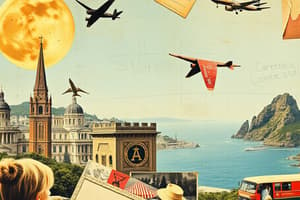Podcast
Questions and Answers
Which of the following is NOT considered a component of a tourism product?
Which of the following is NOT considered a component of a tourism product?
What does 'accessibility' in the context of a tourism product primarily refer to?
What does 'accessibility' in the context of a tourism product primarily refer to?
Which element of a tourism product would include restaurants and shopping centers?
Which element of a tourism product would include restaurants and shopping centers?
According to travel industry standards, what role do attractions play in a tourism product?
According to travel industry standards, what role do attractions play in a tourism product?
Signup and view all the answers
What is meant by 'activities' in the tourism product context?
What is meant by 'activities' in the tourism product context?
Signup and view all the answers
What is a key characteristic that distinguishes tourism products from consumer products?
What is a key characteristic that distinguishes tourism products from consumer products?
Signup and view all the answers
How does the inseparability characteristic of tourism products affect the consumer experience?
How does the inseparability characteristic of tourism products affect the consumer experience?
Signup and view all the answers
Which characteristic of tourism products refers to the inability to hold or evaluate them prior to use?
Which characteristic of tourism products refers to the inability to hold or evaluate them prior to use?
Signup and view all the answers
What does the perishability characteristic of tourism products imply?
What does the perishability characteristic of tourism products imply?
Signup and view all the answers
Why is seasonality a challenge for marketing tourism products?
Why is seasonality a challenge for marketing tourism products?
Signup and view all the answers
Which of the following is an example of an amenity in tourism?
Which of the following is an example of an amenity in tourism?
Signup and view all the answers
What aspect of tourism products reflects the variability of experiences among consumers?
What aspect of tourism products reflects the variability of experiences among consumers?
Signup and view all the answers
What transportation option is considered part of the accessibility feature in tourism?
What transportation option is considered part of the accessibility feature in tourism?
Signup and view all the answers
Study Notes
Definition of a Tourism Product
- Composed of various components including tourist attractions, transport, lodging, and entertainment.
- Blend of tangible (physical) and intangible (emotional) elements, encompassing natural, cultural, and man-made resources.
- Core of destination marketing mix, enhancing overall visitor experience.
Components of Tourism Products
- Attractions: Range from natural wonders to man-made sites, requiring constant updates for maintenance and appeal.
- Accommodation: Any place where tourists can stay, providing lodging options.
- Accessibility: Involves transportation modes like roads, railways, and airports, making locations reachable.
- Amenities: Facilities such as ATMs and convenience stores that ensure tourist comfort.
- Activities: Leisure pursuits available to tourists, such as tours and recreational offerings.
Example: Manila
- Attraction: Intramuros - a historical site.
- Accommodation: Manila Hotel - lodging facility.
- Accessibility: Includes Light Rail Transit (LRT), Metro Rail Transit (MRT), Philippine National Railways (PNR), and local transport options like Grab and jeepneys.
- Amenities: Automated teller machines (ATMs) and convenience stores for tourist needs.
- Activities: Historical tours in Intramuros and museum visits.
Characteristics of Tourism and Hospitality Products
- Intangible: Cannot be physically experienced before purchase; relies on customer perception.
- Inseparable: Purchase and consumption occur simultaneously at the location; experience is tied to place.
- Variable: Tourist experiences vary based on timing, company, and service quality; no two experiences are the same.
- Perishable: Services cannot be stored for future sale; unused capacity (e.g., hotel rooms) represents lost revenue.
- Seasonal: Affecting profitability due to fluctuating travel market behaviors and seasonal variations beyond just weather-related factors.
Studying That Suits You
Use AI to generate personalized quizzes and flashcards to suit your learning preferences.
Description
This quiz explores the definition and components of tourism products, including attractions, accommodations, accessibility, amenities, and activities. It emphasizes the blend of tangible and intangible elements that enhance the visitor experience. Learn through examples, such as key attractions in Manila.




